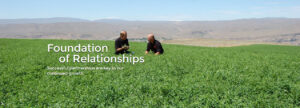The name alfalfa has gone through a few permutations before arriving at its now common name. It is believed that the name originated in an Iranian language in medieval times as aspastor or ispist before being transformed in the Arabic language. According to Wikipedia, al-fisfisa was defined as “an animal feed and consumed in both fresh and dried form” in a 13th century Arabic dictionary. The word itself being used to describe “fresh fodder”.

Historians commonly believe that the final alteration of the name occurred after being introduced to Spain. The Spanish began grazing and farming the hay, calling it alfalfez and then alfalfa. As a country of horsemen, the Spanish placed a high value on alfalfa and considered it the best feed for horses. Spanish colonizers later brought alfalfa to the Americas and the name alfalfa stuck.
Californians began importing alfalfa seed from Chile in the late 1800s. Soon after, the cultivation of alfalfa spread across the entire western United States. Many farmers tried to plant alfalfa on the Eastern seaboard of the United States at the same time. These areas of the United States called the crop lucerne. Unlike the West coast however, try as the might; farmers were unable to grow it with successful results. Even today, there is very little cultivation of alfalfa in that area of the United States.
The name lucerne continues to be used for the legume hay in England, Australia, France, Germany and Brazil. Yet most of the world’s alfalfa is now grown in the western hemisphere. As areas where alfalfa is the common term export more hay, the term for this protein rich hay is gaining ground. The word is now making its way into European languages and may soon nudge lucerne out of favor.


